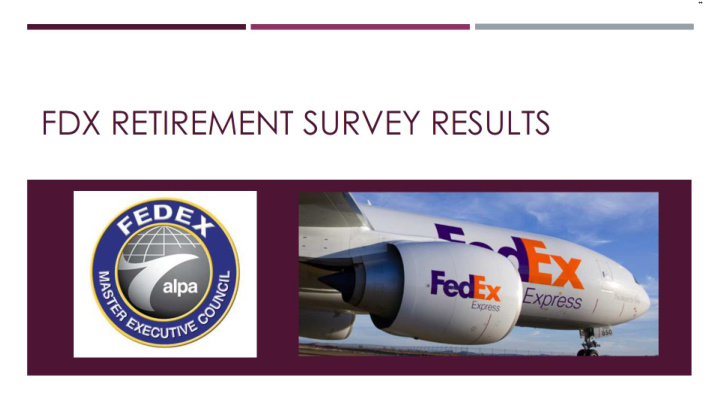



Overall Response rate: 50.2% Confidence Level: 99% Confidence Interval: ±2 (± 1.933)
67.5% 61.6% 52.4% 51.3% 66.0% 52.4% 53.8% 64.5%
72.5% 48.9%
51% 49%
38.5% Age 55 and older 15.0% Age 60 and older
62.0% 38.3%
25.1 % have some form of military retirement benefit
YES: 74.7% NO: 25.3%
YES: 44.1% NO: 55.9%
< Age 60: 6.1% ≥ Age 60: 93.9% @65: 33.9%
Major themes include: • Increased pension benefits • Maintaining insurance • Lifestyle decisions • Divorce/remarriage/children • Debt • Enjoy working
NEEDS IMPROVEMENT GOOD
NEEDS IMPROVEMENT GOOD
78.7 %
47.4%
58.1% 61.5%
79.6% 80.4% 64.5% 83.4%
40.7% 36.2% 23.1%
54.9%
93.6%
69.5%
96.4%
Not included in ‘pensionable’ earnings
Data Summary Statistically significant response rate • Demographics well represented • Domicile/FDA, crew position, aircraft, age, seniority, marital status, military retirement eligibility • Inferences A majority of pilots have a financial plan, but a majority do not use a financial professional • The mean age to commence retirement is 62, with less than 10% indicating their desire to retire early • One third indicate they will retire at 65 • Reasons for a specific retirement age vary greatly but have common categories • Defined Benefit and Defined Contribution Plan knowledge requires improvement in specific areas • Most pilots are aware of their ‘B Fund’ contribution bracket, but less than half know the actual percentage • Pilots expect their investment ROR to decline after retirement • The retirement education efforts of the Association are well received and effective • Pilots recognize a loss of purchasing power associated with a fixed payment Defined Benefit • A majority of pilots do not recognize that the company does not purchase an annuity at retirement • Pilots are realistic with their income replacement ratio desires and comprehend the sources of income • The vast majority of pilots participate in the 401K •
Recommend
More recommend